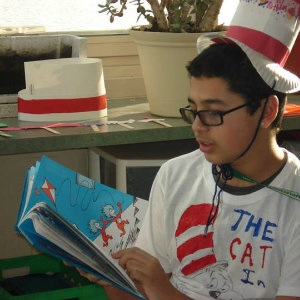 First of all, it’s never too early to instill a passion for reading into your child – and that can begin at infancy, when you read to him or her (and some people even read to their babies in utero!). The American Society of School Libraries lists multiple ways that your child can benefit from reading, quoting the Family Literacy Foundation. These early literacy benefits include:
First of all, it’s never too early to instill a passion for reading into your child – and that can begin at infancy, when you read to him or her (and some people even read to their babies in utero!). The American Society of School Libraries lists multiple ways that your child can benefit from reading, quoting the Family Literacy Foundation. These early literacy benefits include:
- Increased self esteem
- Increased communication among family members
- Introduction to colors, shapes, numbers, the alphabet and more in a fun, age-appropriate way
- Building of listening skills, vocabulary, memory, language skills, imagination, creativity, interests in subjects, positive behavior patterns, value and attitudes
And, of course, they learn the joy of reading.
By the time your child is three to five years old, ICanTeachMyChild.com recommends the following books: alphabet books, song books, picture books and rhyming books.
Do As I Do
Parenting.com emphasizes the importance of monkey see, monkey do. By this, the experts mean that your child should see you reading – and enjoying it. They also recommend a site, lexile.com, where you can enter the name of your child’s current favorite book to receive recommendations of other books that are similar. This way, you can easily find other books that your child will probably enjoy, expanding his or her library and love of reading.
Recommendations to Consider
There are countless reading programs available for kids and, what works for one child doesn’t always work for another. Some children love to play flashcard games, while others might like singing the alphabet song and then making letters out of play dough. Let your child play with foam letters in the bathtub and otherwise make learning fun.
Get books that only contain pictures and let your child tell you the story that he or she imagines from those pictures. Instructables.com suggests that, for four- and five-year-olds, you cut construction paper into 8.5 x 5.5 inch pieces and write simple words such as “I, my, like, a, see, dad, mom, the, dog, is, go, here, said, to, & are.”
Start with one card and, each week, add two new cards. Then ease into simple age-appropriate books. Some books are “predictables,” which means that sentence structure is similar throughout. With these books, children can follow the sentence pattern, and that can give your child confidence.
In an article found on Oprah.com, an expert gives a caution and a tip. The caution is to refrain from “jumping in when they skip a word or miss a sound,” because this can break the flow. The tip is to ask children detailed questions as they read to help develop reading comprehension.
Perhaps the questions could be as simple as “What color hat was Jose wearing?” or “How many kittens did Susie Kat have?”
Different Children, Different Learning Rates
GreatSchools.org points out that children have different levels of phonemic awareness, which means that some can dissect words into its sounds more easily than others can. For some, the ability to recognize the three distinct sounds found in the word “bag” is strong; for them, “learning to read is about as challenging as sneezing.” If you suspect that your child struggles in this area by the time he or she is in school, share your concerns with the teacher. There are assessments available and ways of strengthening core skills.
Looking for educational and enrichment opportunities that will help to prepare your child for school? Horizon Education Centers provides affordable quality child care at the following Northeast Ohio locations.





